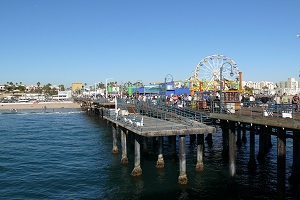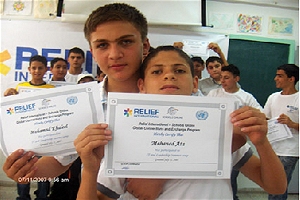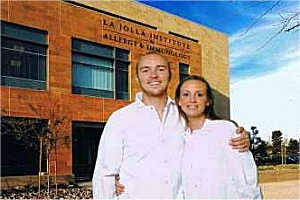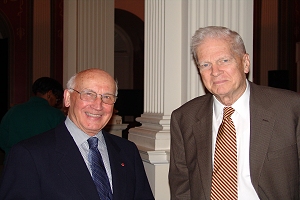Vice Versa
Los Angeles: diversity abounds

Joris Vankerschaver is a Belgian postdoctoral fellow in Control and Dynamical Systems at the California Institute of Technology in Pasadena, California.
It has taken me a few weeks to write down my first impressions of Los Angeles and I’ m still not sure I have got it entirely right. When Ken Coppieters described LA in this column as elusive, I couldn’t but agree with him. How do you go about describing a city which almost has more inhabitants than the whole of either Flanders or Wallonia? Especially if before you were living in Bruges, a quiet medieval town often called "la morte"?
Of course, the complexity of this city only gradually manifests itself. Los Angeles is divided in about 80 interconnected sub-cities, each of them reasonably self independent, allowing newcomers like myself to explore the city in strides without having to cope with 4 million inhabitants (or 13 million if you include the entire metropolitan area), 1215 square kilometers of city, and over a hundred languages all at once.
I live in Pasadena, a suburb to the Northeast of downtown LA, which is locally renowned for its historic town center and its vibrant night life: route 66 once used to cross this town, and some of that old excitement supposedly still lingers here. I wouldn’t be a true Belgian if I didn’t measure the quality of a place by its food, and Pasadena does extremely well on that account: many of the local pubs in Old Town Pasadena even stock up on Belgian beers, and the variety of ethnic supermarkets and restaurants is just bewildering.
This is a city of contrasts, and "bewildering" is maybe indeed the best word to describe it. While Pasadena relatively speaking more or less lives up to my expectations of a typical American town, it takes only a few minutes driving in any direction to end up in a totally different area. For example, the suburbs of Alhambra and Monterey Park, a few miles south of here, are home to tens of thousands of Pacific Asian immigrants. This is no quaint old Chinatown but a bustling modern city in its own right, with road signs in different sets of characters, and businesses advertising their services in the language of the people.
Drive in any other direction and again and again you come across new and different vistas. Examples of this diversity abound throughout the city: Los Angeles is home to a huge Mexican population, the largest Iranian population outside Iran, one of the largest Armenian populations in the world, and probably many, many more. I am not a sociologist, but the motives for immigration are undoubtedly as diverse as the migrant populations themselves, and make for a very diverse and generally hospitable population. Caltech, my home institution, welcomes a large influx of foreigners every year, up to the point where maybe only one out of ten of the grad students and post docs here was born in the US.
Maybe that is the essence of the American spirit: everyone once started out as an immigrant here, and while the masses that arrive here nowadays are in most cases no longer oppressed or poor, that process continues to this day. Even though immigration is nowadays a touchy subject at best, that thought is reassuring.
It remains to be seen whether I will ever manage to begin to understand the complexity of the United States and its people. Even just mastering the rules of American football in time for the kick-off of last Sundays Super Bowl proved to be quite a challenge, but one has to start somewhere!
Add this article to Digg
Recently on Vice Versa
Focus on:online language skills
 An online language skills program is bringing together American and Palestinian secondary school students. In the program, young Palestinians from the West Bank are creating online videos to help American students learn Arabic in their local schools.
An online language skills program is bringing together American and Palestinian secondary school students. In the program, young Palestinians from the West Bank are creating online videos to help American students learn Arabic in their local schools.
Mijn werk in San Diego: focus op diabetes.
 Ken Coppieters is a Belgian scientist working at The La Jolla Institute for Allergy and Immunology and lives with his wife Helena in San Diego, California. He is a regular contributor to this web site. In this article he focuses on his job at The La Jolla Institute in San Diego.
Ken Coppieters is a Belgian scientist working at The La Jolla Institute for Allergy and Immunology and lives with his wife Helena in San Diego, California. He is a regular contributor to this web site. In this article he focuses on his job at The La Jolla Institute in San Diego.
English (via Google)
Toen ik in 2002 in Gent afstudeerde als biotechnoloog, kreeg ik de kans om in het labo van Prof. Dirk Elewaut te gaan werken, een jonge reumatoloog die toen net 5 jaar post-doctoraal onderzoek achter de rug had in, jawel, San Diego. Ik droomde er sinds mijn eerste bezoek aan de V.S. al van om er ooit voor langere tijd te kunnen leven en werken, en toen ik Dirk hoorde vertellen over zijn verblijf aan The La Jolla Institute for Allergy and Immunology was ik dan ook snel overtuigd om de stap te zetten, en koos voor hetzelfde instituut.
Herman Van der Wee says globalization occurs in waves
 One of the world's foremost economic historians, Herman Van der Wee of Belgium, says that globalization is a new word for an old process that has been going on for centuries.
One of the world's foremost economic historians, Herman Van der Wee of Belgium, says that globalization is a new word for an old process that has been going on for centuries.